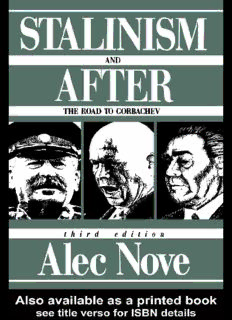
Stalinism and After: The Road to Gorbachev PDF
Preview Stalinism and After: The Road to Gorbachev
Stalinism and After iii Also by Alec Nove Socialism, Economics, and Development The Economics of Feasible Socialism Political Economy and Soviet Socialism The Soviet Economic System Was Stalin Really Necessary? Economic History of the USSR Stalinism and After The Road to Gorbachev Alec Nove University of Glasgow London and New York First published 1975 by Unwin Hyman Inc. Second Edition 1981 Third Edition 1989, reprinted 1990 Simultaneously published in the USA and Canada by Routledge 29 West 35th Street, New York, NY 10001 Routledge is an imprint of the Taylor & Francis Group This edition published in the Taylor & Francis e-Library, 2005. “To purchase your own copy of this or any of Taylor & Francis or Routledge’s collection of thousands of eBooks please go to www.eBookstore.tandf.co.uk.” © 1975, 1981, 1989 by Unwin Hyman, Inc. © 1992 by Routledge All rights reserved. No part of this book may be reprinted or reproduced or utilized in any form or by any electronic, mechanical, or other means, now known or hereafter invented, including photocopying and recording, or in any information storage or retrieval system, without permission in writing from the publishers. British Library Cataloguing in Publication Data A catalogue record for this book is available from the British Library. ISBN 0-203-98744-6 Master e-book ISBN ISBN 0-415-09445-3 (Print Edition) Contents Preface ix 1 Genesis 1 The Russian Political Tradition 1 The Circumstances of Revolution 6 ‘NEP’ and the Rise of the Secretariat 15 The Great Debate: Socialism in One Country 19 The Great Turning-Point 26 2 The System Consolidated 33 The Revolution from Above 33 Privilege, Inequality, Hierarchy, Discipline 40 The Seventeenth Congress and the Great Terror 44 The Purposes of the Purge 50 The Cultural Counter-Revolution and Neo-Nationalism 57 Foreign Policy Turnabouts 63 Economic Policies in the Mid-Thirties 66 3 War 73 Munich and the Nazi-Soviet Pact 73 Stalin’s Biggest Mistake 76 Stalin the War Leader 81 4 The Last Years of Stalin 91 The Brief False Spring 91 viii Stalin and the Cold War 94 Political and Cultural Repression at Home 98 Economic Progress and the Nineteenth Party Congress 102 The End of an Era 105 A Digression: What Explanation for Stalinism? 109 5 Stalin’s Heirs and Stalin’s Legacy 113 Malenkov Outmanoeuvred: Khrushchev Wins Power 121 Khrushchev’s Policies and ‘Destalinisation’ 126 Khrushchev Challenged and Triumphant 138 6 The Fall of Khrushchev and the Rise of Brezhnev 147 The Brezhnev Regime 158 Brezhnevism 172 7 Brezknev’s Death and Gorbachev’s Rise 177 Enter Gorbachev 177 Gorbachev and Stalin 187 Appendix 191 1 Biographical Data 191 2 Chronological List of Events, 1917–85 199 3 Membership of the Party 207 4 Further Reading 209 Index 211 Preface The object of this book is to explain how Stalinism came to be, what was its nature, how it was modified after the despot’s death. To this end I concentrate on causes and trends rather than on detail. If you wish to know the date at which Stalin arrived at Tsaritsyn, the text of any paragraph of the Constitution, or the output of steel in 1980, this is not the book for you. I do not wish to imply that these things are unimportant, and you will find in the list of recommended reading a number of books which deal with them. In fact, it is my hope that you will be sufficiently interested in this dramatic and eventful period to wish to read much more about it. This is not a biography of Stalin, of Khrushchev or of Brezhnev. We are concerned with them, of course, but as political men. We are concerned also with another and vital question: what difference did their personalities make? A great revolution, carried out in the name of equality, freedom and justice, turned into Stalin- despotism. Why? How? Is this explicable primarily in terms of Russia’s historical heritage, or of the Russian revolution and its isolation in a hostile environment, or was it the result of the logic of Leninism, the seizure of power by a Marxist party in a backward peasant country? These are impersonal explanations. Do they miss out the vital factor of Stalin’s peculiar personality? Similarly, we may ask ourselves whether the attempt by Khrushchev to demolish the Stalin myth and to alter course was a personal aberration, and whether this applies also to the partial return to more repressive methods under Brezhnev. This latest edition also takes into account what some regard as ‘the Gorbachev revolution’, which is going on as these lines are written.
Description: